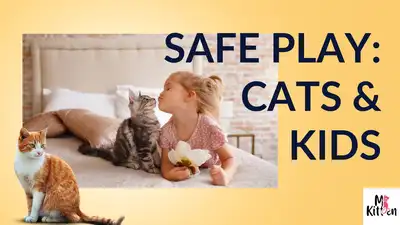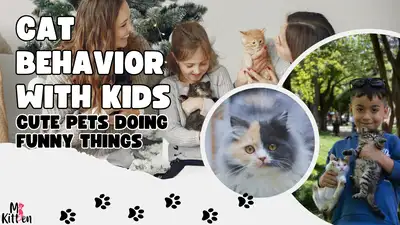Feline-Friendly Fun: Ensuring Safe Play for Cats and Kids
Essential Guide to Cat Dental Health: Preventing Common Oral Issues
Creating a harmonious household where both cats and kids can enjoy playtime together is a top priority for many pet owners in India. Ensuring a positive relationship between them is crucial, as it not only fosters a loving environment but also teaches children how to interact gently with pets.
To achieve this, it’s essential to understand cat behavior, set up a conducive environment, and supervise interactions. By following these guidelines, you can create a relaxed atmosphere where your cat and kids can have fun together safely.
Purrfect Smiles: Keeping Your Cat's Teeth Clean and Healthy
Understanding Cat Behavior Around Children
To ensure safe interactions, it’s essential to understand cat behavior around children. Cats often exhibit specific behaviors when they’re around kids, such as hissing, growling, or avoidance, due to feeling threatened or scared.
When cats feel comfortable, they may initiate play or seek affection. Observing your cat’s body language and reactions around children is crucial. If your cat appears stressed or aggressive, it’s best to intervene promptly.
By recognizing the signs of feline comfort and discomfort, you can facilitate a more harmonious interaction between your cat and kids, ensuring a safe and enjoyable experience for both.
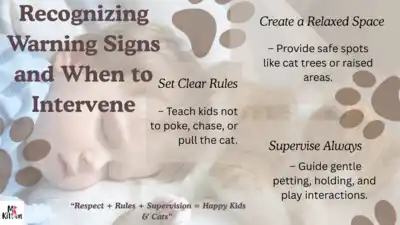
Creating a Relaxed Environment for Safe Play between Cats and Kids
To foster a positive relationship between cats and kids, a calm environment is essential. A relaxed atmosphere helps reduce stress for both cats and children, making their interactions more enjoyable and safe.
Vertical Spaces for Safety
Incorporating vertical spaces is a practical way to ensure your cat has a safe escape route when feeling overwhelmed. Cat shelves or cat trees provide an elevated vantage point, allowing your cat to observe the surroundings without feeling threatened.
Designating quiet retreat areas where your cat can rest undisturbed is crucial. These areas should be away from high-traffic zones and noise sources, allowing your cat to recharge. By providing such spaces, you encourage your cat to feel secure, thereby promoting a more relaxed atmosphere for interactions with children.
Teaching kids to respect these boundaries is also vital. Ensuring they understand when your cat needs solitude will help prevent unwanted interactions and create a more harmonious household.
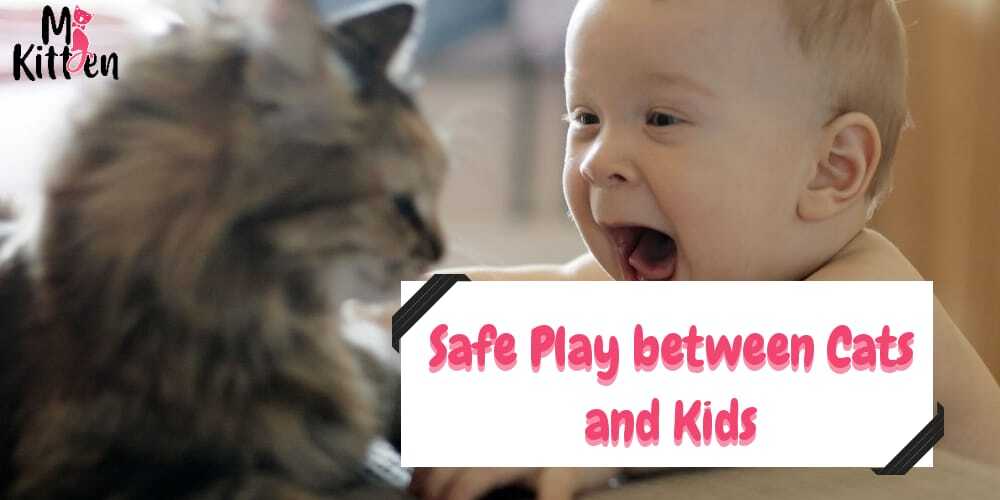
The only thumb rule is to be patient! Good Luck!
Establishing Clear Rules for Interaction
Establishing clear rules is crucial for safe interactions between cats and kids. Teaching children how to gently interact with your cat is fundamental to preventing unwanted reactions.
Children should be taught not to pull their cat’s tail or ears and not to disturb them when they’re sleeping. Demonstrating how to pet your cat gently and respectfully is also important. This helps children understand that cats have personal boundaries.
Rules such as not teasing your cat with toys or hands can prevent aggressive reactions. By setting these boundaries, you help your child understand how to engage with your cat in a way that is safe and enjoyable for both. Consistency in enforcing these rules is key to developing a harmonious household where both cats and kids can coexist happily.
By establishing and enforcing clear playtime rules, you nurture a positive relationship between your cat and child, ensuring their safety and fostering a lifelong bond.

Nurturing Lifelong Bonds Through Supervised Play
Supervising playtime between cats and kids is crucial for their safety and for nurturing a lifelong bond between them. By being present during their interactions, you can intervene if necessary, teaching children how to behave gently and respectfully around cats, thus helping your cat feel more at ease.
This supervised play also reinforces the rules established for their interaction, ensuring both your cat and child understand the boundaries. Over time, supervised play fosters a deeper understanding and affection between your cat and child, creating a more harmonious home environment. Ensuring children and pet safety with cats is a top priority, and supervision is key to achieving this.
By prioritizing supervised play, you can create a loving and safe space for both your cat and child to thrive, promoting a lifelong friendship between them.
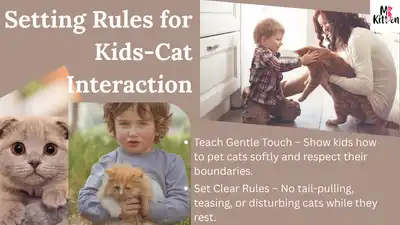
Building Bonds: Ensuring Safe Play Between Children and Cats
Creating a Safe Environment for Feline and Child Interactions
You won’t find more fun combination than of a kid with a cat. They both prove to be wonderful companions who interact with each other and make best of both worlds. Though cats have sharp claws and hairy coats and kids have soft and sensitive skin, but they enjoy each others’ companies a lot. What kids find joy in is the never-ending energy of cats that keeps them entertained and happy. The shrill voices and meows of cats are loved by children and at times, they may even try to replicate them.
Do not worry about your fluffy friend playing with your young one just because of the latter being an animal. In the right circumstances, you might think of building healthy and safe environment when both of them play.
Petting cats at home with kids perfectly teaches them empathy, compassion, self-esteem and kindness. In return, cats get to learn to trust children and develop affection with a positive behavior. Whereas, the cat may lash out at your kid and get angry because of the improper handling. Which would eventually led to hatred and fear in your kids’ mind for the cat.

Teaching Children to Recognize and Respect Cat Behavior
So, to curb this issue, you may make your children understand that the kitty in a friend and not a toy. You can even teach your child to behave properly and show affection to the pets. The little ones should understand that no matter how the cats behave, in the end she’s a companion and a living individual who has feeling just like us humans. Although the kid is afraid of her or her rough actions, playing according to their terms and nature will let your kid gain trust.
The question that your young one might raise while playing with pet is why cats lash out at times. There are situations when the cats lash out and get angry, but these traits need to be avoided. Most of the cats are temperamental, grumpy or naughty, but none of them would ever bite or scratch for no reason. Generally a cat might swipe just because of stressful, annoyed or threatened feel. On the contrary, some cats are so friendly that they will get over excited when tickled or while playing with a following toy.
The children can also be taught to learn the signs when the cat is angry or is going to strike. Some of the common signs are flattened ears, thrashing tail, hissing, growling or arched backs. All these are warning signs that indicate towards the bad mood of the pet. If the child knows about how to handle such tantrums, the future mishaps have a high possibility of being avoided.
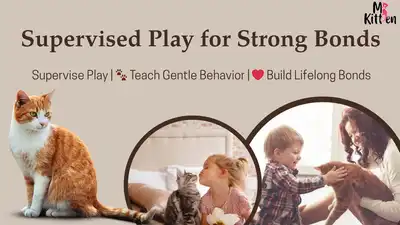
Recognizing Warning Signs and When to Intervene
Your cat might be the one with bad-temper and may have a history of biting and scratching. Letting your kid play with such a pet isn’t a good idea. Also, if your children are so young that they do not have a self-control behavior then you must be really careful while trying to develop relationship between the two.
There are some ways in which you can build a safe play environment between the two.
Setup a relaxed environment
Make sure your cat gets a spacious yet safe place to relax, lounge and play. You may think of getting a cat tree or a raised place so that they get a great view of their surroundings. Doing so will help keep them away from the young ones’ hands.
Set some rules
While interacting or teaching your kid, make sure that they learn to keep their calm and stay quiet while playing with a cat and avoid screaming or running away. It all depends on the age and maturity level of the kid, they can be taught to not to poke, scratch or pull the cat. And that the cats should not be followed or chased once they decide to hide.
Supervision is the key
Pre-schoolers and toddlers can be instructed to stroke the cats and give them a belly-rub. Children can be demonstrated how petting feel s and can be guided to place their hands softly over their fur. Some overexcited cats may bite while being petted. Older kids can be taught how to hold the cats in their arms. Placing hands properly on her torso and the other one on rear-end for great stability.
Seeing your child and your kitten having fun together can be rewarding for you. The main key for maintaining a safe playtime is a respectful behavior, educational toys and your supervision. With such tricks and knowledge, you would be able to easily develop a bond of love and friendship between the cat and the kid!


